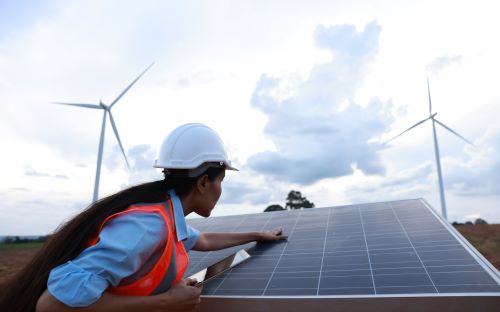India’s mining industry has a poor health and safety record, despite many of the mines being owned by the union and state governments. However, trade unions warn that plans to privatise mines could further erode safety standards, putting workers’ lives at even greater risk.
Features
Mining in India is fraught with danger
India’s mines are dangerous by any standard, with one mine worker dying every six days on average in 2017, according to government data. So it’s no surprise that India is one of the world’s most dangerous countries to be a coal miner.
This year has been no different for coal mine workers, with India witnessing a series of accidents that killed nearly a dozen miners.
In April, two coal mine workers were killed in the Bhupalpally Mandal district of Telangana following a roof collapse in the Kakatiya Khani (KTK) coalmine, operated by the Singareni Collieries Company Limited (SCCL), a coal mining company that is jointly owned by the Telangana government and the union government.
In another incident at SCCL in August, three people, including two SCCL workers and a contract driver, were killed when a high-capacity dumper rammed into a Bolero vehicle on the premises of the Opencast Project-II in Manuguru town in Telangana.
 Photograph: iStock/Supratim BhattacharjeePhotograph: iStock/Supratim Bhattacharjee
Photograph: iStock/Supratim BhattacharjeePhotograph: iStock/Supratim Bhattacharjee
Meghalaya state also reported two mining accidents that left nine dead and two missing this year. On the morning of 21 January in Meghalaya’s East Jaintia Hills district, six miners fell 150 feet to their death at a coal mine in the Sorkari Dienshanlalu village near Rymbai. Also, on the morning of 30 May, five miners were trapped in an illegal coal mine in the district after a dynamite explosion. Three bodies have been retrieved so far.
When multiple agencies were involved in the rescue of 15 miners trapped in a ‘rat hole’ mine in Meghalaya in December 2018, data tabled in the Lok Sabha in January 2019 by the Labour and Employment Ministry revealed that 377 workers involved in the mining of coal, minerals and oil were killed in accidents between 2015 and 2017. Of the 377, more than half, 210, were killed in coal mines.
In addition, thousands of workers, including children, have been killed in rat hole mining, which involves miners crawling into narrow shafts on bamboo ladders to mine for low-quality coal, in Meghalaya.
Fatalities 'are under-estimated'
Industry experts, including senior officials employed by the world’s largest coal miner, state-owned Coal India Limited (CIL), concede that the official fatality numbers could over-estimate the actual number of deaths that take place deep inside the mines. A major reason for the high number of accidents is workplace health and safety precautions are almost non-existent.
In February, the union minister of coal, parliamentary affairs and mines Pralhad Joshi informed the Rajya Sabha that 84 people died due to 254 serious accidents in coal mines between January 2019 and November 2020. Nearly 70 per cent of the incidents took place in mines owned by SCCL in Telangana.
Coal mines operated by SCCL recorded 37 fatal accidents, and 583 serious accidents between 2017-2020. Of the 188 fatal accidents and 763 serious accidents in the country, Telangana, Chhattisgarh and Jharkhand have accounted for the highest number of casualties.
When it comes to coal mining accidents, the country has a higher proportion of casualties resulting from the collapse of the roof and sides of underground mines than from the use of explosives, which account for the majority of the accidents in nations such as the United States and China.
Roof and bunker collapses
This was reaffirmed by Joshi in September 2020, when he informed the Lok Sabha that roof and bunker collapses and rope haulage have been identified as factors which often contribute significantly to fatalities deep inside the mines. He added that the number of accidents in coal mines was higher than the number of accidents in non-coal mines since 2017.
SCCL, however, insists that the number of accidents has fallen significantly compared to previous years. Agreeing that underground mines were more prone to serious accidents, SCCL general manager (coordination and marketing), K Ravi Shankar said that previously, SCCL used to witness 25-30 fatal mishaps every year. “This has dropped now,” he said.
Ravi Shankar added that opencast mines which operate during daytime require a smaller workforce. SCCL, which employs nearly 45,000 workers, has so far produced 64.4 million tonnes of coal mined from underground and opencast mines.
Joshi said underground coal mining was more hazardous as geo-mining conditions in underground mines are totally different to those in non-coal mines and open pit mines. “The risk factor of employees is also more in underground mines,” he said.
Talking about health and safety measures, Ravi Shankar said SCCL is minimising hand-loading operations while using more high-capacity machines. “We have also set up man-riding systems where the miners need not walk. This helps in lowering workers’ fatigue,” he added. “Resin capsule support is provided to roof walls to avoid their collapse and ensure safety of workers.”
‘Glaring deficiencies’
However, after the recent fatal accident at SCCL, activists from the Singareni Coal Mines Karmika Sangh trade union said the ghastly tragedy exposed glaring deficiencies in the health and safety arrangements. The SCCL management should focus on improving safety standards in both underground and opencast coal mines, they said.
Speaking about accidents in mines across the country, Nathulal Pandey, president of Hind Khadan Mazdoor Federation trade union, and S Q Zama, secretary general of the Indian National Mineworkers’ Federation, said: “A shortage of manpower, high production targets, unplanned extraction of coal, outsourcing coal production to third parties, engagement of a large number of untrained contract workers in critical areas, not fully using safety budgets for the past three years, lack of safety equipment for all workers, and not following safety measures continue to cause avoidable accidents and a loss of workers’ lives in the mines of CIL and SCCL.”
Another activist from the Centre of Indian Trade Unions (CITU) said: “Little has been done to change the situation and inspections are neither regularised nor thorough. Funds are insufficient. In addition to state mines, there are private mines – mostly small – whose owners are less concerned with their workers and more with turning a profit.”
Privatisation fears
The right-wing Modi government’s decision to auction coal blocks to private players has also left trade unions and workers employed by CIL and SCCL worried. They are concerned that the welfare of nearly 350,000 workers employed by CIL and SCCL is now at risk.
“The government’s attempts to allow commercial mining and privatisation of CIL may actually worsen the safety situation,” said Pandey.
Activists claim that privatisation of mines and mining operations will lead to a huge increase in the number of contract workers and the adoption of unsafe and irresponsible mining practices. “Commercial mining with the primary objective to gain profit will undermine social protection and conservation of coal benchmarks set by the public sector,” added Zama.
One of the reasons why the Coal Mines (Nationalisation) Act was enacted in 1973, bringing private sector coal mines into state ownership, was their poor health and safety record. The operations of coal mines are regulated by the Mines Act 1952, and the Directorate General of Mines Safety (DGMS) is responsible for ensuring all mines comply with health and safety laws, and any violations of safety statutes or guidelines are pointed out by them during their inspections. However, work at state-run mines remains highly dangerous.
Lapses in safety
Coal workers have also long been protesting against the rising tide of outsourcing in CIL, highlighting inequalities in wages and benefits and lapses in health and safety.
When an opencast coal mine operated by CIL-subsidiary Eastern Coalfields Limited (ECL) collapsed at Lalmatia in Jharkhand in December 2016, leaving 18 workers dead and five missing, questions were raised not only about the safety standards adopted by coalfields and adherence to mining laws, but also the rampant outsourcing of coal extraction in CIL and its eight subsidiaries. In the incident, several tonnes of excavated earth collapsed on the mine workers, all of whom were migrants hired from poor regions in neighbouring states by a contractor.
“The accident occurred because migrant workers, who had warned bosses of imminent danger, were forced to continue mining work at a dangerous place,” said a resident of Neema, a village near the Lalmatia mines. “They were able to force those labourers to work in a dangerous mine because the migrants lacked local contacts and support to back them.”
However, many employers in the mining industry often argue that ‘illiterate’, ‘ignorant’ and ‘agriculturist’ mineworkers are frequently involved in ‘reckless’ and ‘misadventurous’ mining, therefore causing accidents.
In January 2017, the DGMS told the Jharkhand High Court the Lalmatia site was not fit for mining activities. A team of officials had inspected the mine three months before the fatal accident in December 2016. They found that the mine safety measures were not adopted as per norms. DGMS sources say there was criminal negligence on part of ECL officials and the outsourced company.
Trade unions said that in many cases adequate health and safety measures are not implemented by contractors while Coal India’s inspection procedures are not up to standard.
Following the fatal incident at the Lalmatia mine, the then chief minister of Jharkhand, Raghuvar Das, announced Rs 2 lakh compensation for the families of those killed in the collapse and Rs 25,000 financial aid to the injured.
Safety fines ‘are too low’
Several experts say a lack of investment in coal mines is one of the main reasons for the industry’s high casualty rate. Accidents during surface transport by heavy machinery in open-cast mines, and the use of explosives, are the other key reasons. They also point out that monetary penalties – such as fines for safety breaches – are too low to incentivise companies to aggressively maintain a safe environment.
Also, compensation payments to workers and their families in the event of fatal and serious injuries and accidents are low, even at state-owned coal firms. It was only in 2019 that the Coal Ministry tripled compensation for fatal mine accidents to Rs 15 lakh. “But it’s not enough,” say activists of the Singareni Coal Mines Karmika Sangh, who are demanding that the company management immediately sanction Rs 1 crore ex-gratia each to the bereaved families of the deceased.
In its July 2014 report, the National Human Rights Commission mentioned the need for the mining sector to gain exposure to best practices from across the world. This, it said, included using scientific ‘training need assessment’ for officers and miners, developing effective training delivery mechanisms and working on comprehensive and specialised training on accident investigation.
In its 2012 report entitled India: Mining Industry Out of Control, Human Rights Watch states: “And because of a dangerous mix of bad policies, weak institutions, and corruption, government oversight and regulation of India’s mining industry is largely ineffectual. The result is chaos.”
The report adds: “Even government officials acknowledge that the mining sector faces a myriad of problems, including widespread ‘illegal mining’. But this report argues that an even bigger problem is the failure of key regulatory mechanisms to ensure that even legal mine operators comply with the law and respect human rights.
“International law obliges India’s government to protect the human rights of its citizens from abuses by mining firms and other companies. India has laws on the books that are designed to do just that, but some are so poorly designed that they seem set up to fail.”


FEATURES

India’s path to net zero: a work in progress
By Orchie Bandyopadhyay on 08 April 2025
India is implementing a variety of clean energy measures to hit its target of net zero greenhouse gas emissions by 2070, including plans to rapidly scale up the generation of nuclear power. However, climate experts say significant finance will be required from developed countries to phase out coal power, accelerate renewables deployment and expand the national electricity grid.

Too hot to handle: early arrival of heatwaves in India sparks calls for action to protect workers and the public
By Orchie Bandyopadhyay on 08 April 2025
Temperatures in India in February 2025 were the hottest since records began over a century ago, prompting warnings the country needs to urgently step up efforts to protect both workers and the general population from the health risks posed by extreme heat and humidity.

